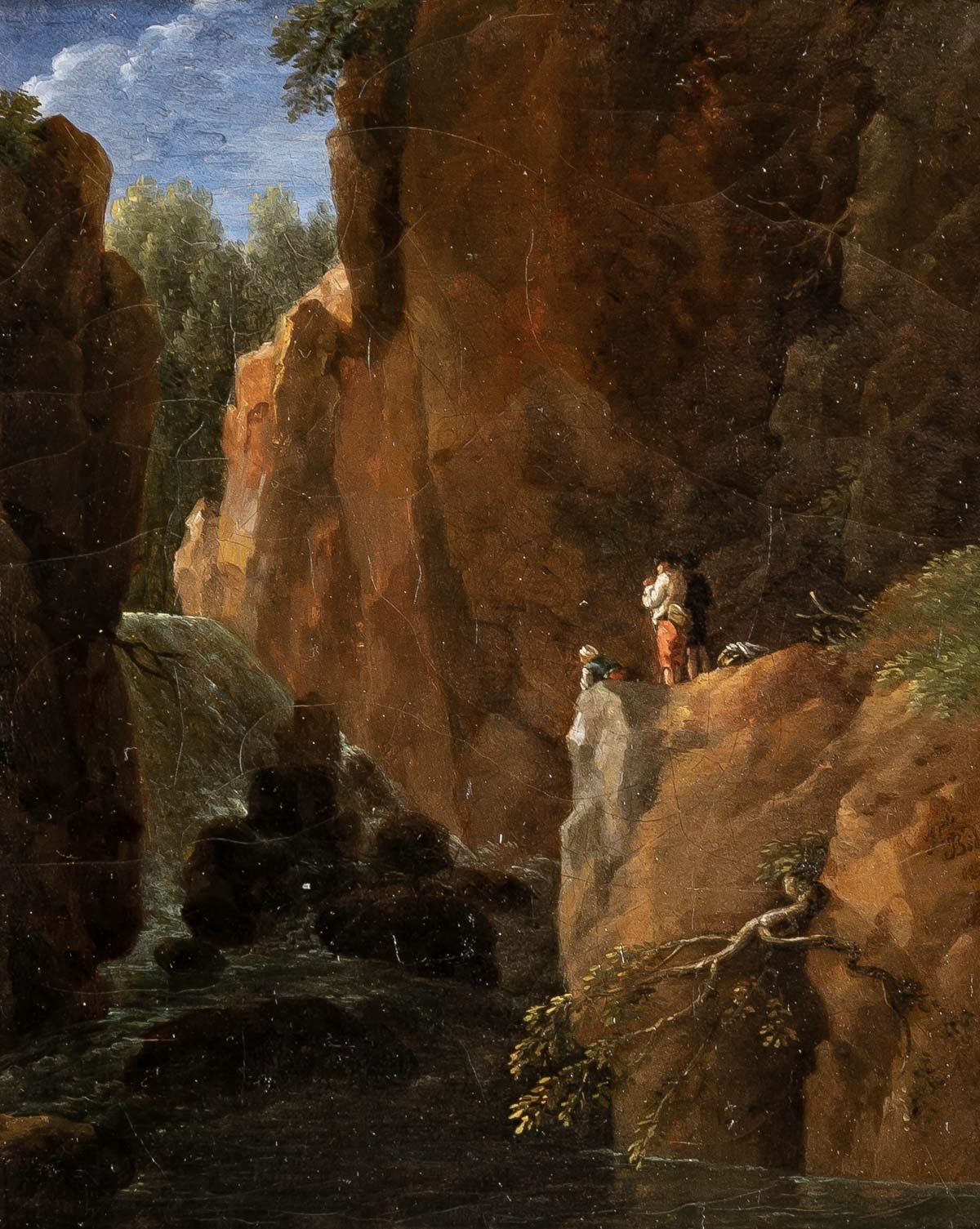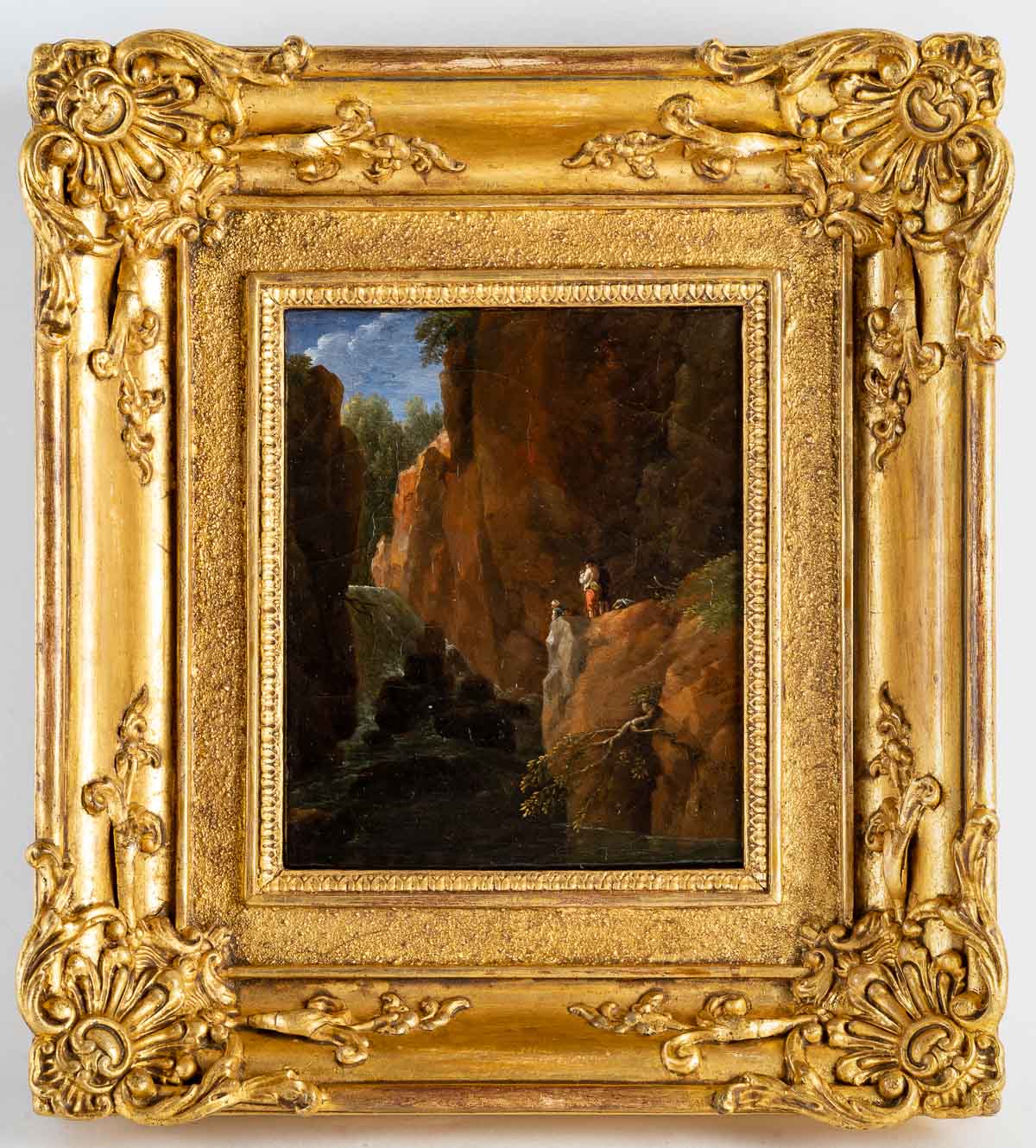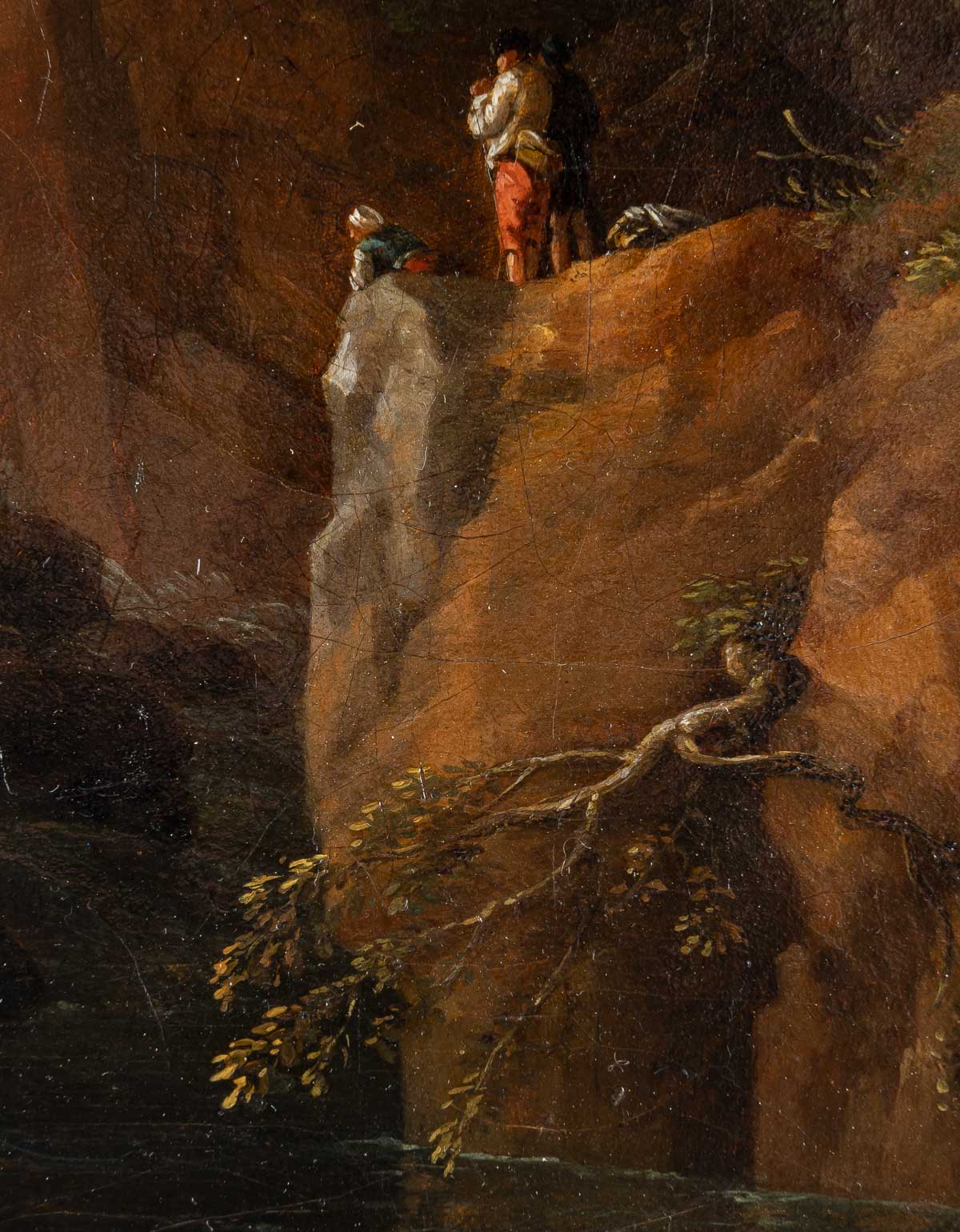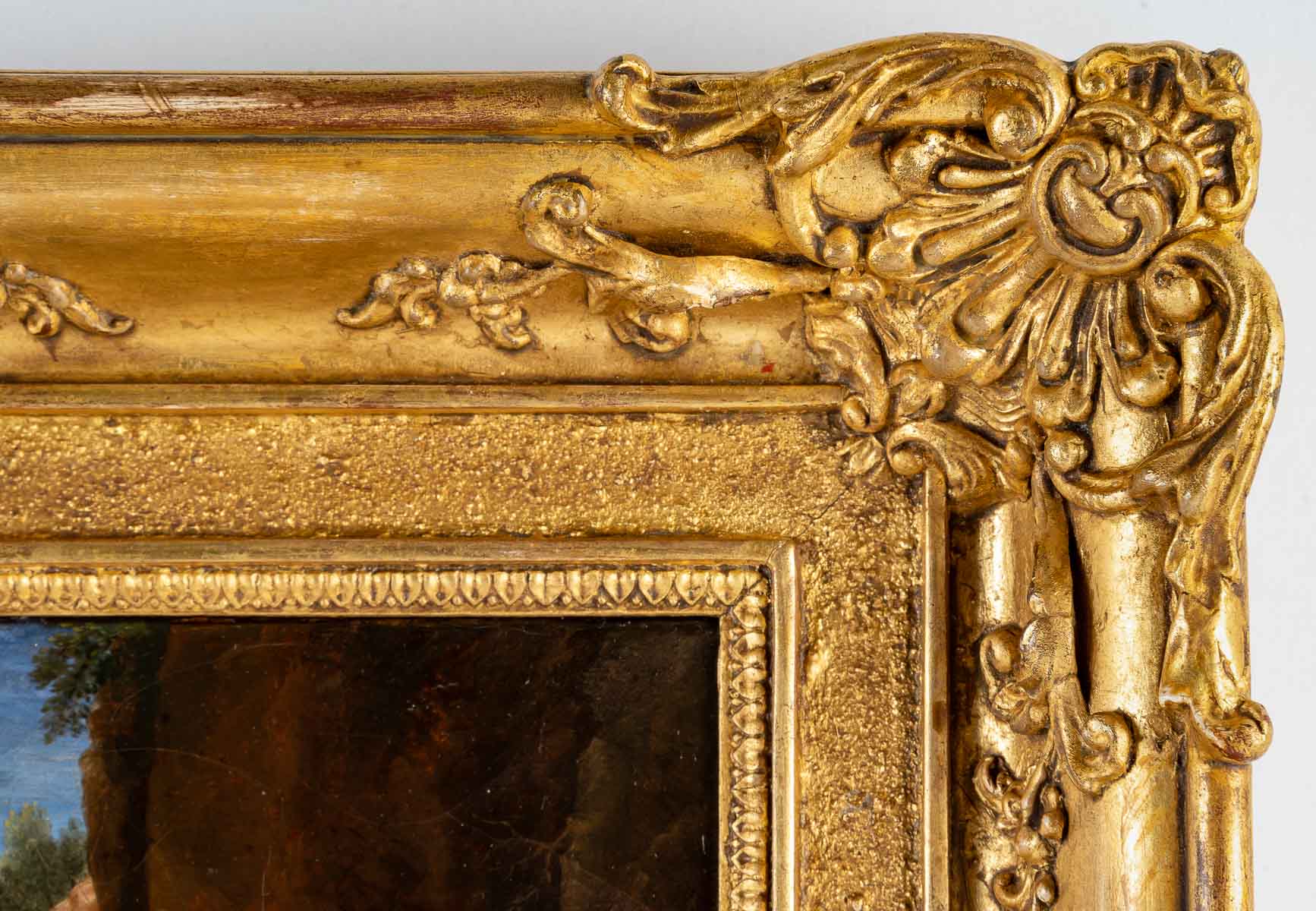Jean-Joseph-Xavier BIDAULD (1758- 1846 )
A romantic Italian landscape by Jean Joseph Xavier Bidauld representing a mountain view with a waterfall in Italy, dated 1823 painted on the motif.
Oil on canvas
Signed and dated on the right side.
Period inscription on the back of the frame: “Bidauld, la grotte…”
Numbered 81 on the stretcher and frame.
Dimensions: 17 x 14 cm
With frame: 30 x 27 cm
SOLD
Jean Joseph Xavier Bidauld, a landscape painter in Italy
In this romantic painting by Jean Joseph Xavier Bidauld nature is honored; the painter expresses his emotion in front of a grandiose Italian landscape.
Three characters in the alcove of the rocks enjoy the beauty of the view. They are tiny in the face of the grandeur of the elements.
A romantic Italian landscape painted on site
The small format of the work is conducive to painting on the ground.
Our painting perfectly illustrates Jean Joseph Xavier Bidauld’s practice of sketching in the open air; his taste for unprecedented views and sites, grandiose which diversify the points of view, the mountains, the rocks where vegetation and waterfalls cling to him, which he transcribes with a meticulous and supple writing.
His palette favors ochre and red tones and the range of greens
In the second half of the 18th century, the practice of landscape sketching, done in oil and in the open air, spread widely throughout Europe. From all over Europe, artists flocked to Italy to paint the monuments of Rome and the idealized landscapes of the Roman countryside. The school led by Pierre-Henri de Valenciennes and Jean-Joseph-Xavier Bidauld is part of this European movement. These landscape painters of the first half of the nineteenth century are now considered the very first plein air painters, although their compositions are still idealized. These artists took a first step towards a new vision of landscapes in painting until the emergence of the landscapes of the new generation of the Barbizon School.
“Mr. Bidauld had pushed the passion of the landscape to the point of going to establish himself for months in front of a site, with a canvas of three or four feet, to paint on the spot all day […] in spite of the accidents even of the temperature, and to leave his post only after having finished his painting “.
Bibliography
The first landscape painter to be admitted to the Académie des Beaux Arts in 1823, Bidauld belongs to the first generation of classical landscape painters of which he is, with J. V. Bertin, N. Didier Boguet and Valenciennes, one of the best representatives.
His brother gave him his first artistic training, then Jean-Joseph-Xavier studied at the School of Fine Arts in Lyon. He was influenced by Dutch painting, and a trip to Geneva introduced him to high-mountain landscapes.
In 1783, Bidauld was in Paris and received advice from J. Vernet. As an authentic pioneer, he made studies on the spot in the forest of Fontainebleau. At first an ardent defender of the historical landscape, he opposed the new naturalist school. His trip to Italy from 1785 to 1790 and the many oil paintings he made on the spot were to prove decisive, enabling him to find his own expression and define his style.
On his return to Paris, he exhibited at the Salon de Paris for the first time in 1791, where he remained until 1844. He won a gold medal in 1812. He quickly became successful and received a prize for encouragement
Bibliography
– Lydia Harembourg – “Dictionary of French landscape painters in the 19th century”.
-Casimir-François-Henri Barjavel, Dictionnaire historique, biographique et bibliographique du département de Vaucluse, Carpentras, C.F.H. Barjavel, 1841, t. I, No. 5
– Ernest Chesneau, Art in the Imperial Residences. Compiègne, Paris, E. Panckoucke et Cie, 1863, p. 46.
– Marie-Madeleine Aubrun, “La tradition du paysage historique et le paysage naturaliste dans la première moitié du xixe siècle français,” L’Information d’histoire de l’art, no. 2, March-April 1968, pp. 63-72, repr. fig. 2, p. 65.
– Suzanne Gutwirth, “Jean-Joseph Bidauld. Une sensibilité néoclassique,” in Jean-Joseph-Xavier Bidauld (1758-1846). Paintings and drawings [cat. exp. Carpentras, Musée Duplessis; Angers, Musée des Beaux-Arts; Cherbourg, Musée Thomas-Henry, 1978], Nantes, imp. Chiffoleau, 1978, n.p.
– Élisabeth Foucart-Walter, Illustrated summary catalog of paintings in the Louvre and the Musée d’Orsay. V. French school. Appendices and index. Liste des tableaux déposés par le Louvre, Paris, Réunion des musées nationaux, 1986, p. 205.
-Jean-Marie Moulin, Guide du Musée national du château de Compiègne, Paris, Réunion des musées nationaux, 1992, p. 49.
Museums
United States
– Los Angeles, Getty Center
– New York, Metropolitan Museum of Art
France
– Avignon, Calvet museum
– Carpentras, Comtadin-Duplessis Museum
– Cherbourg-Octeville, Thomas Henry Museum:
– Dijon, Magnin Museum:
– Grenoble, Grenoble Museum
– Lyon, Museum of Fine Arts
– Meudon, Museum of Art and History
– Toulouse, Augustins museum
– Valencia, Museum of Art and Archaeology
Paris:
-Louvre Museum :
View from Subiaco, 1789, oil on paper pasted on canvas,
View of the town of Avezzano, on the shores of Lake Cellano, Naples
Landscape of Italy: view of Isola del Liri, near Sora, 1792-1793,
Landscape of Italy, 1793,
Historical Landscape: Psyche and the God Pan, ca. 1819,
-Musée Marmottan Monet : The Castle of Scönbrunn, 1810,
With Carle Vernet, Promenade de Napoléon Ier et de Marie-Louise auchâteau de Saint-Cloud, 1811,
Source
https://www.chateau-maisons.fr/Explorer/Nos-collections/paysage-monumental-d-Italie-de-1820
https://compiegne-peintures.fr/notice/notice.php?id=11








